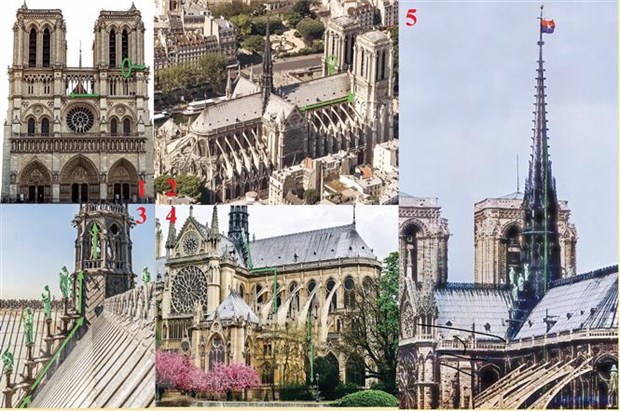 Photos depicting the process of Swiss boys climbing to the top of the Notre Dame Cathedral in Paris to hang the Vietnamese flag. (Photo: Thu Ha/VNA)
Photos depicting the process of Swiss boys climbing to the top of the Notre Dame Cathedral in Paris to hang the Vietnamese flag. (Photo: Thu Ha/VNA)In the struggle to liberate the South and unify the country, Vietnam received very important support in many forms from international friends .
Fifty-four years ago, three young Swiss men, Bernard Bachelard, Olivier Parriaux and Noé Graff, expressed their support for Vietnam by traveling from Switzerland to France to hang the flag of the National Liberation Front of South Vietnam on the top of the Notre Dame Cathedral in Paris on January 19, 1969, the day the Four-Party Conference on Vietnam officially began in Paris.
On the occasion of the 50th anniversary of the signing of the Paris Agreement on Vietnam (1973-2023) and the 48th anniversary of the liberation of the South and reunification of the country (April 30, 1975-April 30, 2023), Bernard Bachelard, Olivier Parriaux and Noé Graff, all now in their 80s, recounted the inspiring journey of the event of raising the half-red, half-blue flag with a bright yellow star on the top of the Notre Dame Cathedral in Paris that day.
Lesson 1: Journey to Paris to support peace for Vietnam
Although the story took place more than 50 years ago, through the retelling, VNA reporters still feel the enthusiasm, courage and idealism of the three Swiss friends, who were all active in movements against the Vietnam War.
Mr. Olivier Parriaux said that as soon as they heard that US President Lyndon B. Johnson announced a temporary halt to bombing North Vietnam and was ready to sit at the negotiating table, the three of them realized that conducting these negotiations in Paris from January 18, 1969 would be an event worth "celebrating" because it would lead to international recognition of the National Liberation Front of South Vietnam after 9 years of its establishment.
“We knew that the Paris talks would finally open the week of January 19… To commemorate this event in a memorable and resonant way, we decided to choose a high place, not the Eiffel Tower, but a place of great humanity and respect for the whole world , which is Notre Dame Cathedral,” he said.
According to the plan, Olivier Parriaux, then a 25-year-old physics student, and Noé Graff (24, a law student) were to act as drivers and guards, assisting Bernard Bachelard, a 26-year-old physical education teacher, in climbing to the top of the tower.
The flag of the National Liberation Front of South Vietnam was personally prepared by Bernard Bachelard’s skillful wife. At that time, it was not too difficult to find the flag of the National Liberation Front of South Vietnam because the anti-war protest movement was strong.
They plan to climb the Viollet-le-Duc spire of Notre Dame Cathedral barehanded at night, without any climbing equipment, and hang the flag on a cross at the top 96m high.
"This action required careful preparation because we were not Parisians, and we did not know exactly how to reach that summit. But as soon as it was announced that the negotiations would begin on January 18, 1969, we borrowed a 2CV and set off," recalls Olivier Parriaux.
After hours of traveling on the A6 road, the three young Swiss men arrived in Paris around noon on Saturday, January 18, 1969, with, apart from the half-red, half-blue flag, only a roll of silk, a long rope, a hacksaw and a few French francs.
The winter weather that day was quite windy, with temperatures above 4 degrees. Joining the flow of tourists before the end of the tour, they arrived at the South Bell Tower at around 3:30 p.m., reaching the first entrance of the tower at a height of 45 meters and the upper floor of the skylight connecting the two bell towers.
After a period of observation, two young men, Bernard Bachelard and Olivier Parriaux, found the way up to the bell tower of Notre Dame Cathedral.
Darkness fell around 6 p.m. With Noé Graff watching, the two men followed the water trough along the nave of the cathedral to the foot of the tower and slowly climbed, with difficulty and risk.
There were sections where they had to squeeze through the gaps between the folding blades of the shutters, hugging giant oak beams to descend 10m below, their bodies covered in centuries of dust.
There was no continuous path from the bell tower to the gargoyle wall as shown in the atlas in the library that the three had studied, forcing them to jump a distance of 2m at a height of 35m.
Mr. Olivier Parriaux said: "It was dark. His back was against the wall of the bell tower, there was no place to retreat to gain momentum, Bachelard jumped over without difficulty. As for me, I jumped over just barely, luckily I was held back."
Another difficult passage is the nave-transverse intersection, where a series of bronze reliefs dedicated to the evangelist St. Mark are placed, beginning with the winged lion symbol.
These statues are installed on pedestals with steep steps of more than 2m without any protrusions to hold on to - the height of the statues is more than 3m.
It took the two of them an hour of climbing and rappelling to reach the body of the spire, finally reaching the first open corridor around 9 p.m. From here, the journey was easier because they were indoors.
Despite these surprises, the two of them arrived at the foot of the tower on time. Bacchus slung the silk sash over his shoulder and tied the end of the climbing rope to his belt.
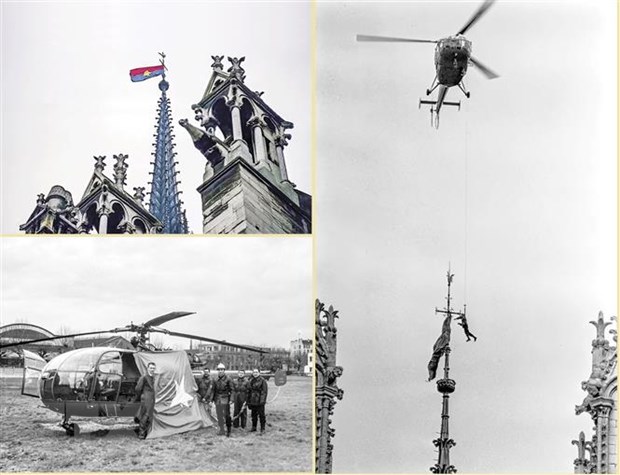 Images of firefighters using a helicopter to remove the Vietnamese flag from the top of the Notre Dame Cathedral in Paris were published in international media. (Photo: Thu Ha/VNA)
Images of firefighters using a helicopter to remove the Vietnamese flag from the top of the Notre Dame Cathedral in Paris were published in international media. (Photo: Thu Ha/VNA)The silk flag measures 3x5m, with a reinforced border to accommodate a string with a spring-loaded hook at both ends. The flag is arranged in the shape of an accordion rather than rolled up so that it can be unrolled without twisting; the silk roll is held together by ten elastic bands connected by a 12m long thin rope.
The bare-handed climb to the top of the tower began at around 10pm. On the north side of the tower were iron bars attached to the wall, spaced about 60cm apart.
The tower's spire has an octagonal cross-section, with gothic decorative "hooks" along its eight sides - relief patterns depicting tree buds, grouped in the shape of a crown and spaced about 2m apart.
Holding on to these supports, the two climbed slowly, checking as they climbed to make sure the next iron bar was still firmly anchored to the wall after a century of rain, wind, and thermal cycles.
The closer they climbed to the top of the tower, the more they could feel the wind blowing through their bodies. They could see the dance of the left bank of the Seine in the distance, and the almost flat roofs of the churches below.
Olivier Parriaux continued: "I stopped 3m below the 1m diameter crown of roses and lilies. I would stay here while Bacchus made his final and most risky climb at 22:45: the ascent to the cross. Overcoming the difficult height of the rose crown, Bacchus climbed the metal pole to the foot of the 6m high cross and grabbed the pattern at the foot of the cross. Climbing the vertical bar of the cross in pole-climbing style, Bacchus grabbed the decorative motifs at the cross's cross points, and attached the spring hook of the top flag."
Thanks to Bernard’s bravery, everything went smoothly. On the way down, Bernard Bachelard and Olivier Parriaux sawed off some iron bars to prevent firefighters from reaching the tower, ensuring that the flag would stay atop the tower long enough for people to notice it the following day, Sunday, January 19.
After a brave and somewhat risky 30-hour journey by young men from Switzerland, on January 19, 1969, the half-red, half-blue flag with a bright yellow star of the National Liberation Front of South Vietnam fluttered in the blue sky of Paris, under the admiring eyes of the people and tourists.
The event became a hot topic for the international press. Many days later, major newspapers in France, the US and many other countries published pictures of the flag flying on the tower’s roof, with thrilling details of the flag’s removal, along with theories about who hung the flag./.
Lesson 2: The spread of the liberation flag













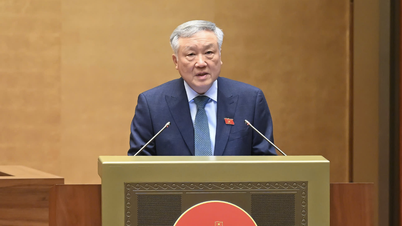

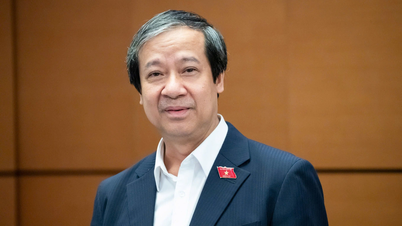












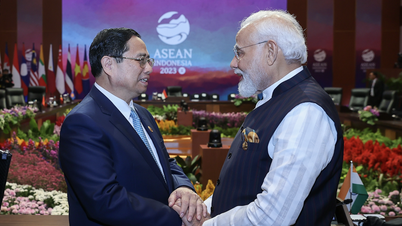
![[Photo] The 9th Congress of the Party Committee of the Office of the President, term 2025-2030](https://vphoto.vietnam.vn/thumb/1200x675/vietnam/resource/IMAGE/2025/6/20/78e7f27e8c4b4edc8859f09572409ad3)
























![[Maritime News] Wan Hai Lines invests $150 million to buy 48,000 containers](https://vphoto.vietnam.vn/thumb/402x226/vietnam/resource/IMAGE/2025/6/20/c945a62aff624b4bb5c25e67e9bcc1cb)














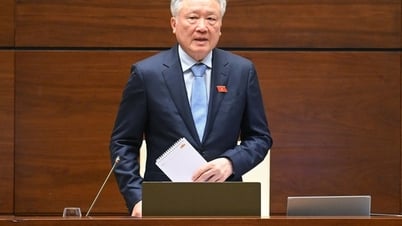

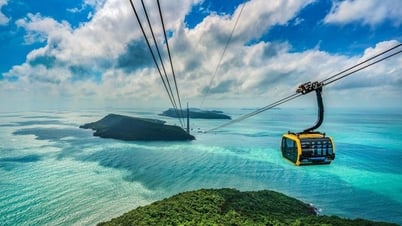
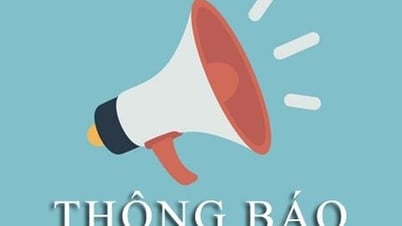


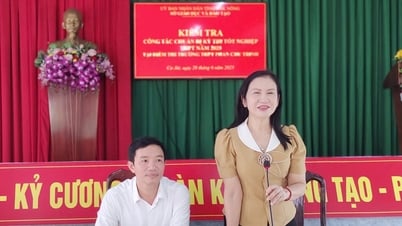







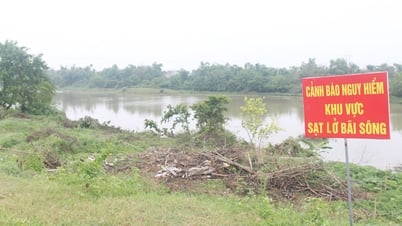

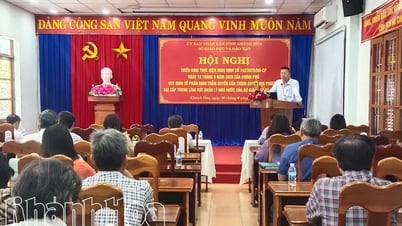













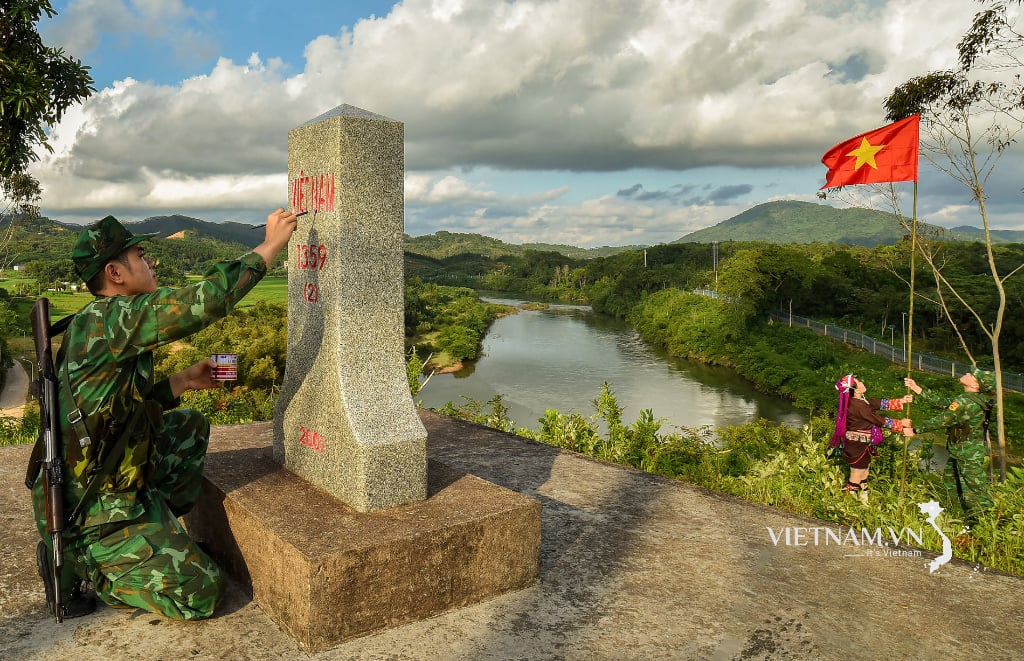

Comment (0)